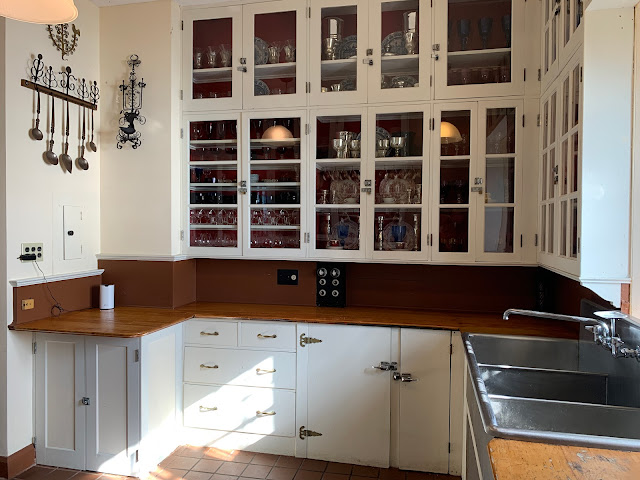Earlier in the month, HM and I went to stay with our son Andy and his wife Kristin. On these trips we usually try to visit someplace we've never been before and this time it was Hammond Castle Museum. It sits on the rocky cliffs overlooking Gloucester Bay and there's great views of the ocean everywhere, even the steps going down to the castle from the parking lot. Here's Andy pretending he isn't worried that we're taking too many photos and not paying attention to where we're walking.
Constructed in the late 1920's in the style of a medieval castle, it was the home and laboratory of John Hays Hammond, an inventor credited with developing the foundation of all modern radio remote control devices. He also was an avid collector of artifacts from ancient Rome through the Renaissance, and they are on display as well as incorporated into the building. The leaves were definitely well past their peak but that was okay. It was a beautiful day in the mid 70's F. in November, no one was complaining!
The Great Hall was designed to give the impression of a Gothic cathedral and it was mostly used for concerts. Steps at the opposite end from the massive organ lead up through an actual medieval arch that marks the entrance into the courtyard.
According to the guide book, the courtyard was designed to represent a 15th century French village outside of a 13th century cathedral that had been built around ancient Roman ruins. Probably without the HVAC systems and glass roof but you've got to admit it's a good story.
Hammond sourced most of his artifacts by himself in Europe and he bought three 15th century shopfronts prior to building his dream home. These two stores, a butcher on the ground floor with a wine merchants offices above, came from Amiens, France.
A bakery, originally from Tours, France, is on the right. The 13th century arch surrounding the entrance to the Great Hall (or the cathedral, depending on your point of view) was found in pieces among rubble in Naples, Italy.
Since medieval villages would have had a communal water supply, it offered the perfect excuse for an indoor swimming pool. Apparently, the 2nd century Roman sarcophagus (which was never used as a coffin) served as the diving board. Along with the columns, it completes the ancient Roman ruins part of the courtyard's story.
A view from one of the guest bedrooms overlooking the courtyard.
Apart from the Great Hall and courtyard, the rooms were large but not cavernous and it was probably a fairly comfortable home.
The Butler's pantry, was almost the same size as the kitchen, which was located below, on the ground floor. Seeing the kitchens preserved in historic homes is always a bonus.
The Bay of Gloucester was looking a little rough that day but since it was so warm and sunny, it didn't seem too much of a threat. However, after looking at the iron work on the windows, I'm wondering were they made that way to make it look more like a castle or as protection from the storms?
There is some access to the oceanside areas but it is built on a cliff so space is limited. This rock reef is called Norman's Woe and no one seems to know why. Maybe it has something to do with the numerous shipwrecks it's caused due to being underwater at high tide? Longfellow was inspired to write "The Wreck of the Hesperus" by it's reputation. I was forced to memorize that poem in middle school and have tried to forget about ever since. Now I know where it all began.
Andy and Kristin were great hosts, as always. Here they are, still smiling at the end of the tour! If you find yourself in the Boston area, it's a great day trip and definitely a place worth visiting.
Thanks for stopping by, see you soon!















Cool!
ReplyDelete